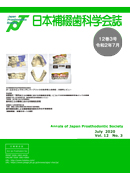Volume 12, Issue 3
July 2020
Displaying 1-16 of 16 articles from this issue
- |<
- <
- 1
- >
- >|
Preface
-
Article type: Preface
2020 Volume 12 Issue 3 Pages 205-206
Published: 2020
Released on J-STAGE: August 13, 2020
Download PDF (887K)
Erratum
-
Article type: correction
2020 Volume 12 Issue 3 Pages 208
Published: 2020
Released on J-STAGE: August 13, 2020
Download PDF (476K)
Invited Articles
-
Article type: Invited Article
2020 Volume 12 Issue 3 Pages 209-224
Published: 2020
Released on J-STAGE: August 13, 2020
Download PDF (1044K)
Position Paper
-
Article type: Position Paper
2020 Volume 12 Issue 3 Pages 225-226
Published: 2020
Released on J-STAGE: August 13, 2020
Download PDF (784K)
Invited Articles
-
Article type: Invited Article
2020 Volume 12 Issue 3 Pages 227-233
Published: 2020
Released on J-STAGE: August 13, 2020
Download PDF (2275K)
-
Article type: Invited Article
2020 Volume 12 Issue 3 Pages 234-242
Published: 2020
Released on J-STAGE: August 13, 2020
Download PDF (3801K)
Review
-
Article type: review-article
2020 Volume 12 Issue 3 Pages 243-256
Published: 2020
Released on J-STAGE: August 13, 2020
Download PDF (2679K)
Case Repor
-
Article type: case-report
2020 Volume 12 Issue 3 Pages 257-263
Published: 2020
Released on J-STAGE: August 13, 2020
Download PDF (3428K)
Original Articles
-
Article type: research-article
2020 Volume 12 Issue 3 Pages 264-271
Published: 2020
Released on J-STAGE: August 13, 2020
Download PDF (1670K) -
Article type: research-article
2020 Volume 12 Issue 3 Pages 272-279
Published: 2020
Released on J-STAGE: August 13, 2020
Download PDF (1813K)
Case Reports (Specialist)
-
Article type: case-report
2020 Volume 12 Issue 3 Pages 280-283
Published: 2020
Released on J-STAGE: August 13, 2020
Download PDF (1429K) -
Article type: case-report
2020 Volume 12 Issue 3 Pages 284-287
Published: 2020
Released on J-STAGE: August 13, 2020
Download PDF (1638K) -
Article type: case-report
2020 Volume 12 Issue 3 Pages 288-291
Published: 2020
Released on J-STAGE: August 13, 2020
Download PDF (1573K) -
Article type: case-report
2020 Volume 12 Issue 3 Pages 292-295
Published: 2020
Released on J-STAGE: August 13, 2020
Download PDF (1557K) -
Article type: case-report
2020 Volume 12 Issue 3 Pages 296-299
Published: 2020
Released on J-STAGE: August 13, 2020
Download PDF (1582K) -
Article type: case-report
2020 Volume 12 Issue 3 Pages 300-303
Published: 2020
Released on J-STAGE: August 13, 2020
Download PDF (1503K)
- |<
- <
- 1
- >
- >|
